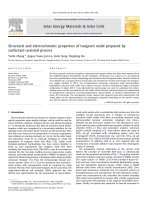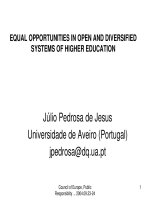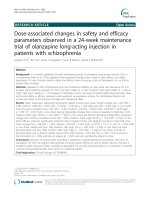Changes in sensory and microbiological parameters of paneer nuggets prepared by steam cooking method under storage conditions
Bạn đang xem bản rút gọn của tài liệu. Xem và tải ngay bản đầy đủ của tài liệu tại đây (215.58 KB, 6 trang )
Int.J.Curr.Microbiol.App.Sci (2019) 8(3): 727-732
International Journal of Current Microbiology and Applied Sciences
ISSN: 2319-7706 Volume 8 Number 03 (2019)
Journal homepage:
Original Research Article
/>
Changes in Sensory and Microbiological Parameters of Paneer Nuggets
Prepared by Steam Cooking Method under Storage Conditions
Rajender Kumar1, S. Sivakumar2*, Rekha Chawla2 and S.K. Mishra2
1
2
NDRI Karnal, Haryana, India
College of Dairy Science and Technology, Guru Angad Dev Veterinary and Animal Sciences
University, Ludhiana, India
*Corresponding author
ABSTRACT
Keywords
Paneer nuggets,
Steam cooking,
Sensory,
Microbiological,
Storage, Aerobic
packaging
Article Info
Accepted:
07 February 2019
Available Online:
10 March 2019
Starting with the paneer as a base material, paneer nugget was prepared by the
addition of food additives such as spices mix, condiments, refined wheat flour, skim
milk powder and sodium caseinate by steam cooking method. Keeping in view of the
health benefits, the steam cooking method was used for preparation of paneer nuggets
as compared to deep fat frying.The present study was envisaged to evaluate the
changes occurred in sensory and microbiological parameters of paneer nugget under
storage conditions. The shelf-life of paneer nuggets with aerobic packaging was found
to be 2 and 9 days respectively at ambient and refrigeration temperature. Nine-point
hedonic scale was employed to carry out the evaluation of samples for sensory
attributes such as colour and appearance, texture, sweetness, flavour and overall
acceptability.
Introduction
million tonnes by the year 2020 (NDDB
2018).
The ever-increasing demand for the ready to
eat snack foods leads to the emergence of
innovative dairy products like paneer nuggets
which was prepared by steam cooking
method. The main reasons for the demand of
ready to eat snack foods are due to increase in
disposable incomes, changes in consumer
concerns, perceptions on nutritional quality
and safety of food. With the status of largest
milk producer in the world, it is expected that
the India’s milk production will reach 185
Milk is considered to be complete food and
about half the milk produced is consumed in
the liquid form and the remaining half is used
to prepare dairy products. Keeping in view of
the importance of value addition of milk and
milk products, the variety of traditional and
value-added dairy products has been
manufactured by converting the surplus milk
during the flush season of milk production as
a means of preservation with longer shelf life
727
Int.J.Curr.Microbiol.App.Sci (2019) 8(3): 727-732
which adds value to milk and also creates
employment opportunities to large number of
small producers especially women and poor,
milk vendors and milk processors (Chandel
and Chauhan, 2010; Patil, 2011). These
traditional dairy products have made a great
impact in the social, cultural and economic
prospects of Indian heritage and are gradually
becoming popular all over the world
(Bandyopadhyay et al., 2006).
College. Good quality raw materials like
spices, condiments, and skim milk powder,
refined wheat flour and sodium caseinate
were procured from reputed brands. The
packaging material LDPE was procured from
local market Ludhiana. Toned milk obtained
was converted into paneer using method
followed by Bhattacharya et al (1971). The
paneer nugget was prepared by steam cooking
method using autoclave as per the procedure
followed by Kumar et al., (2018).
Paneer nugget can be prepared by paneer as a
base material along with addition of food
additives such as spices mix (black pepper,
chilli powder, coriander powder and turmeric
powder), condiments (ginger and garlic
paste), refined wheat flour, skim milk powder
and sodium caseinate for preparation of
paneer nuggets by steam cooking method.
Different methods can be employed for
cooking of paneer nuggets such as deep fat
frying and battering. Based on the health
benefits and economic aspect, steam cooking
method was used for preparation of paneer
nuggets, further this method not only improve
the parameters such as yield, sensory
characteristics, shelf life and also reduces the
cost of production. Quality of the Indian dairy
products deteriorates due to post manufacture
contamination and also during storage. The
appropriate packaging method enhances the
shelf life of food products by protecting them
from different deteriorative changes such as
sensory and microbiological etc. Keeping in
view of this background, the present study
was carried out with the objective of to study
the changes in sensory and microbiological
parameters of paneer nuggets packed with
aerobic packaging under storage conditions.
To evaluate the shelf life of paneer nuggets
product was cooled immediately after
manufacturing and converted into small
cuboidal pieces and sample sufficient for
storage study was packed in LDPE and stored
at controlled ambient (25 1oC) and
refrigeration (41oC) temperature in aerobic
packaging till spoilage. The product was
analysed for its sensory attributes and
microbiological parameter (IS: 1981) at the
regular interval of 1 day at controlled ambient
(251oC) and 3 days at refrigeration (41oC)
temperature conditions. Sensory profile of
stored product was evaluated by a panel of
seven semi-trained panellists with the help of
9 point hedonic scale.
Results and Discussion
Effect of storage on sensory properties of
paneer nuggets stored at refrigeration
(41oC) and controlled ambient (25 1oC)
temperature under aerobic packaging
A gradual decrease in the sensory scores of
paneer nuggets was observed during storage
due to the different changes occurring with
increase in period of storage i.e. oxidation of
fat, loss of moisture, increase in acidity along
with the textural changes. All the sensory
parameters decreased slowly at refrigeration
(41oC) temperature as compared to
controlled ambient (25 1oC) temperature
(Figure 1 and 2) in aerobic packaging. The
Materials and Methods
The samples of investigation were
manufactured in the Experimental Dairy plant
and analyses of samples were conducted in
the Dairy Technology laboratory of the
728
Int.J.Curr.Microbiol.App.Sci (2019) 8(3): 727-732
flavour, colour and appearance, texture,
chewiness and overall acceptability scores of
fresh paneer nuggets at initial day were 8.06,
8.08, 8.10, 8.25 and 8.12, respectively.
respectively in aerobic packaging The effect
of storage period was significant on sensory
scores and multiple comparison test indicated
the mean values for different storage
parameters differs significantly (p< 0.05) on
different days of storage. Similar trend of
decrease in sensory scores was observed by
Singh et al., (2014).
The colour and appearance scores decreased
from 8.08 to 6.55 and 8.08 to 6.84 after 2
days of storage at controlled ambient (25
1oC) temperature and 9 days storage at
refrigeration
(41oC)
temperature,
respectively in aerobic packaging. The
decrease in colour and appearance score was
may be due to evaporation of moisture from
the surface of the paneer nuggets. The
decrease in colour scores was statistically
significant (p<0.05).
The product was acceptable for 2 and 9 days
when stored at controlled ambient (25 1oC)
and refrigeration (41oC) temperature,
respectively in aerobic packaging. The effect
of storage period was significant on sensory
parameters and multiple comparison tests
indicated the mean values for different
sensory parameters differ significantly
(p<0.05) on different days of storage.
Similarly the texture scores decreased from
8.10 to 6.39 and 8.10 to 6.35 after 2 days of
storage at controlled ambient (251oC)
temperature and 9 days storage at
refrigeration
(41oC)
temperature,
respectively in aerobic packaging. Texture
became hard due to loss of moisture during
storage and this could be the reason for
decrease in texture scores.
Effect of storage on microbiological
properties of paneer nuggets stored at
refrigeration (41oC) and controlled
ambient (25 1oC) temperature under
aerobic packaging
Various types of microorganisms produce
decay in the perishable food products leading
to the substantial losses of nutrients and
considerable changes in properties takes place
in the food material. The microbiological
stability of heat processed food is affected by
temperature and duration of the thermal
process. The products which are under
processed are liable to microbial spoilage and
over processed are inferior in nutritional
aspects. Microbiological changes in paneer
nuggets during storage are given in Figure 3
and 4. The increase in SPC could be attributed
to favourable environmental factors like
temperature, relative humidity, storage
conditions and food factors like pH, water
activity, moisture and nutrients present.
Flavour scores decreased from initial value of
8.06 to 6.04 and 6.54 after 2 and 9 days
storage at controlled ambient (251oC) and
refrigeration
(41oC)
temperature,
respectively in aerobic packaging. Chewiness
scores also decreased at both the
temperatures, decreasing from initial value of
8.25 to 6.08 and 6.82 after 2 and 9 days
storage at controlled ambient (25 1oC) and
refrigeration
(41oC)
temperature,
respectively in aerobic packaging Overall
acceptability score, which is the average value
of all other sensory parameters shown a
decreasing trend with the progression of
storage period. Overall acceptability score
decreased from initial value of 8.12 to 6.13
and 6.66 after 2 and 9 days storage at
controlled ambient (25 1oC) and
refrigeration
(41oC)
temperature,
The standard plate count of paneer nuggets
increased significantly (p<0.05) during
storage at refrigeration (41oC) temperature
729
Int.J.Curr.Microbiol.App.Sci (2019) 8(3): 727-732
in aerobic packaging. The standard plate
count increased from 0 log cfu/g on initial day
to 2.47 log cfu/g on 9th day at refrigeration
(41oC) temperature in aerobic packaging,
coliform count increased from 0 log cfu/g on
initial day to 1.59 log cfu/g on 9th day at
refrigeration (41oC) temperature in aerobic
packaging whereas the yeast and mold count
increased from 0 log cfu/g on initial day to
1.69 log cfu/g on 9th day at refrigeration
(41oC) temperature in aerobic packaging.
Although most of the microorganism present
were destroyed by the steam cooking but the
increase in count with increase in storage
period may be due to post production
contamination. The effect of storage period
was significant on microbiological parameters
and multiple comparison tests indicated the
mean values for different microbiological
parameters differ significantly (p<0.05) on
different days of storage.
Fig.1 Effect of storage period on sensory properties of paneer nuggets stored at controlled
ambient (251oC) temperature (Aerobic Packaging)for 2 days
Fig.2 Effect of storage period on sensory properties of paneer nuggets stored at refrigeration
(41oC) temperature (Aerobic Packaging)for 9 days
730
Int.J.Curr.Microbiol.App.Sci (2019) 8(3): 727-732
Fig.3 Effect of storage period on microbiological properties of paneer nuggets stored at
controlled ambient (251oC) temperature (Aerobic Packaging) for 2 days
Fig.4 Effect of storage period on microbiological properties of paneer nuggets stored at
refrigeration (41oC) temperature (Aerobic Packaging) for 9 days
At
refrigeration
(41oC)
temperature
psychrophiles might have predominated in
their growth and multiplication. The yeast and
mold count in fresh product was not detected.
The increase in acidity during storage leads to
favourable environment for the growth and
multiplication of yeast and mold. Coliform
count increased significantly during entire
storage period at either temperature
conditions. This refrigeration (41oC)
temperature significantly reduces the growth
of spoilage organisms, thus the product shelf
life was increased as compared to ambient
temperature. Similar trends were observed by
Kumar and Bector (1991): Kumar et al (2007)
and Lamdande et al (2012).
It was concluded that the shelf-life of paneer
nuggets with aerobic packaging was found to
be 2 and 9 days respectively at ambient and
refrigeration temperature. The product can be
further utilized as a ready to eat healthy snack
food for the benefit of the consumers.
731
Int.J.Curr.Microbiol.App.Sci (2019) 8(3): 727-732
Effect of different levels of citric acid
on the physico-chemical and sensory
attributes of buffalo milk paneer. In:
Proceedings of the International
Conference on Traditional Dairy
Foods. National Dairy Research
Institute, Karnal-India, November 1417.
Lamdande, A. G., Shyam, R. G. and Kumar,
A. 2012. Impact of edible coating and
different packaging treatments on
microbial quality of paneer. Journal of
Food Process Technology.3 (6): 2226.
NDDB
2018.Milk
production
/>s/Pages/Milk-Production.aspx
India
(Accessed on 20.12.2018).
Patil, G. R. 2011. Traditional dairy products:
present status and strategies to
promote exports. In: Proceedings of
the
Brainstorming
session
on
“Promotion of Indigenous Dairy
Products in International Market” held
at National Dairy Research Institute,
Karnal, India.
Singh, R. R, Singh, R. and Shakya, B. R.
2014. Impact of Turmeric addition on
the Properties of Paneer, Prepared
from different types of Milk.
International Journal of Current
Engineering and Technology.4: 187483.
References
Bandyopadhyay, M., Mukherjee, R. S.,
Chakraborty, R. and Raychaudhuri, U.
2006. A survey on formulations and
process techniques of some special
Indian
traditional
sweets
and
herbalsweets. Indian Dairyman.58: 2335.
Bhattacharya, D. C., Mathur, O. N.,
Srinivasan, M. R. and Samlik, O. L.
1971. Studies on the method of
production and shelf life of paneer
(cooking type of acid coagulated
cottage cheese). Journal of Food
Science and Technology. 8:117–20.
Chandel, B. S. and Chauhan, A. K. 2010.
Present situation and future potential
for milk processing in India. Indian
Journal of Dairy Science.63: 283-91.
IS: SP 18 (Part XI) 1981. Handbook of food
analysis. Part XI, Dairy Products.
Bureau of Indian Standards. Manak
Bhavan, New Delhi.
Kumar, P. and Bector, B.S. 1991.
Enhancement of shelf-life of paneer
with food additives. Ind. J. Dairy Sci.,
44: 577–584.
Kumar, R., Sivakumar, S., Chawla, R. and
Talwar, G. 2018. Studies on
optimization of paneer nuggets: ready
to eat steam cooked product. Indian
Journal of Dairy Science. 71(1):13-19.
Kumar, S., Rai, D.C. and Verma, D.N. 2007.
How to cite this article:
Rajender Kumar, S. Sivakumar, Rekha Chawla and Mishra, S.K. 2019. Changes in Sensory and
Microbiological Parameters of Paneer Nuggets Prepared by Steam Cooking Method under
Storage Conditions. Int.J.Curr.Microbiol.App.Sci. 8(03): 727-732.
doi: />
732









